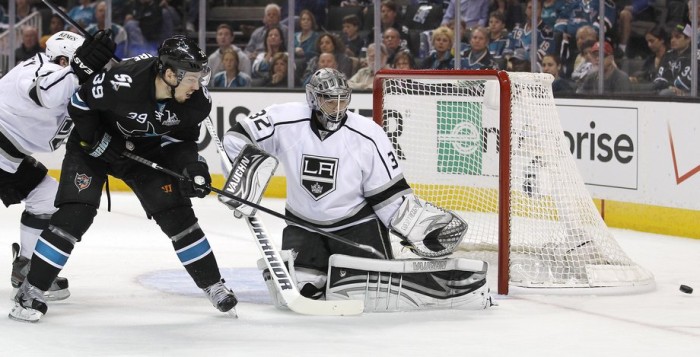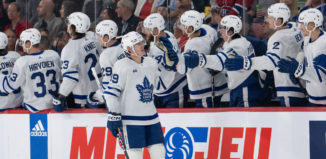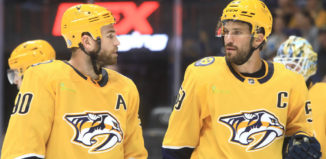LA Kings – SJ Sharks Playoff Preview
We’re taking a brief look at some key players as two contenders go head-to-head in what will likely be one of the best and most physical, hard hitting series in the first round. Having seen each other in three of the last four seasons (2012 was the only year they didn’t play) as well as being division rivals, these two teams are quite familiar with each other. While there are some newcomers on both teams, the core players have an intense dislike for their opponent on the ice.
Here are the projected lineups for Game 1:
San Jose
Pavelski-Thornton-Burns
Marleau-Couture-Nieto
Hertl-Sheppard-Wingels
Torres-Desjardins-Havlat
Vlasic-Demers
Stuart-Braun
Hannan-Boyle
Niemi
Los Angeles
Gaborik-Kopitar-Williams
King-Richards-Carter
Toffoli-Stoll-Brown
Clifford-Lewis-Nolan
Muzzin-Doughty
Regehr-Voynov
Mitchell-Martinez
Quick
These are just projected lines and neither McLellan nor Sutter are hesitant to change up their lines if they feel they can get a more favorable matchup or if things aren’t working out as expected/hoped.
If you haven’t seen it already, check out Jewels from the Crown’s Playoff Preview. For a look from the opposition, Fear the Fin takes a look at key players that the Sharks should be aware of on the ice. Jon Rosen of LA Kings Insider does an excellent job as always of previewing the series from LA’s and San Jose’s perspectives.
Key Players to Watch
These are the guys who will be critical to their teams’ successes and failures. Let’s start with the most obvious (and important) place: goaltending.
Goaltending
Antti Niemi: Obviously Niemi didn’t have as strong of a season this year as he did in 2013 when he was a Vezina finalist. He’s had some trouble with rebounds, which should be a focus for the Kings. If he performs as well as he did in last year’s playoffs (which was excellent. He kept his team in it every game), this will be an extremely tough series for LA. However, if he’s off his game even a little, the Kings should have a slight edge on the Sharks.
Jonathan Quick: One of the most athletic, explosive goaltenders in the league, Quick has a unique style all his own. Described as crab-like with a strong butterfly foundation, Quick is an extremely limber and aggressive netminder. The key for the Sharks will be to shoot high glove side and get him moving laterally. Being so aggressive often leaves tons of room exposed as it becomes difficult to get back in time to take away that space. As with Niemi, if he is off his game even a little bit, the Sharks’ firepower should be enough to overcome the Kings’ stalwart defense.
For a better breakdown between the two netminders, check out Kevin Woodley’s piece here. It is well worth a look to understand the strengths and weaknesses of both men.
Defense
San Jose:
Marc-Edouard Vlasic. He should probably be in the Norris Trophy conversation as he had a stellar regular season. Playing with a revolving door of partners on the right side, Vlasic has shut down top opponents and was a +31 on the season. While I don’t put much stock into +/-, that’s pretty impressive. San Jose is going to rely on Vlasic to be able to shut down the Gaborik-Kopitar-Williams line which has been extremely dominant since Gaborik came over at the trade deadline.
The remaining question is: will San Jose’s other defensemen step up and will it be enough?
Los Angeles: The Kings’ young puck movers are key to their breakout and as they struggle, so the team’s struggles will go as well.
Slava Voynov. While no doubt Drew Doughty is obviously LA’s most important defenseman (they’re not winning anything without him in the lineup), Voynov is another critical piece to the Kings’ defense. He had somewhat of a quiet year, only managing to score 4 goals, but did rack up 30 assists. They’ll need another strong postseason showing from him as they have the past two seasons if they hope to go far.
Jake Muzzin. A year ago as a rookie, he was exposed in the playoffs and seemed to lack confidence there. While being paired primarily with Doughty on the top unit this season, Muzzin appears to have come leaps and bounds from where he was following last year’s abbreviated season. He’s gotten much better about limiting his mistakes (a year ago, he seemed only capable of turning the puck over). However, he’ll have to be extra careful during the postseason as the mistakes he does make are often glaring.
Drew Doughty. He’s most dangerous when he has the puck behind his own blue line, especially when his team is down a goal (as exemplified here). One of the best defenseman in the league at a single man breakout, Doughty leads by example, plays in all situations and will be leaned on heavily by Sutter. He was injured when the Kings last met the Sharks in a meaningless game on April 3 and was held out of the lineup as a precaution. His health will be of the utmost importance as the Kings look to make a deep playoff run again this year. Boasting such attributes as excellent gap control, good speed and a high hockey IQ, the key to shutting down LA begins with shutting down Doughty and getting him off his game.
Forwards
San Jose:
Joe Thornton. Centering the first line, “Jumbo” will be counted on to carry his team on his back as he did in last year’s playoffs. One of the most memorable moments was in Game 3 when his line came roaring out and absolutely dominated just about everyone on the ice. His leadership and incredible playmaking skills will be crucial for a Sharks’ victory.
Joe Pavelski. This one is a little tricky. He had an incredible career year during the regular season scoring 41 goals and getting 38 assists. He also did it while switching between winger on Thornton’s line and centering the Sharks’ third line. The Sharks are a much deeper team down the middle if “Little Joe” slots in at C3 instead of James Sheppard, who is much worse in comparison to Pavelski. He’s clearly most effective at third line center and may be McLellan’s best option to compete with the Kings. At least down the middle.
Tomas Hertl. Not much is known about the dynamic rookie, except that he’s very good at disrespecting the league. He appeared to be on track to compete with other rookie sensation Nathan MacKinnon of the Colorado Avalanche before an unfortunate open ice collision with Kings’ captain Dustin Brown caused him to miss most of the rest of the season. He did play in the Sharks’ final two games of the season on Thornton’s wing, which allowed Pavelski to go back to centering the third line. If he’s in the lineup (which he appears to be right now), he completely changes the depth of the Sharks and potentially makes them more dangerous, depending on how effective he can be and how McLellan chooses to use him.
Los Angeles:
Dustin Brown. Playing with a knee brace all season seemed to really hamper his mobility. While he claims it wasn’t an excuse, he’s openly admitted that he’s the type of player that he doesn’t like anything touching his skin, not even tape. Brown seemed to be rejuvenated following a return from the Olympics. After taking off the knee brace, he became a far more effective player. His speed seemed to have returned and even his scoring touch looked like it was making a comeback as he finished the season with 15 goals (not a career best or worst by any means, but a positive sign considering how bad his season was). The Kings will need another performance similar to the one he had in 2012 if they hope to make another deep playoff run.
Mike Richards. Known more for his grit and tenacity than his goal scoring ability (though he’s expected to have that as well), Richards has been having a miserable season for one reason or another. Finishing with 11 goals, a near career low, the two-time 30 goal scorer has likely started to decline and it shows. He struggled all season long and finished with a -3% corsi rel (meaning, the team controlled 3% more shots when he was not on the ice than he was on the ice. To put that into perspective, Kopitar finished with 6% corsi rel, highest among forwards and second only to Muzzin). The Kings are going to need the Big Game Player to show up in the playoffs and for him to be as effective as he was the past two postseasons, especially given that he’s (at the moment) back to centering the second line. If he can be effective, he can help mitigate the damage being matched up against Joe Thornton will cause.
Marian Gaborik. The biggest concern will be if he can stay healthy. If he can, the Kings look incredibly deep.
Special Teams
The Kings were one of the most penalized teams during the regular season and partially as a result, their PK numbers took a hit. They went from being Top 10 to 12th in the league, which isn’t bad for the amount of time they spend killing penalties. On the flip side, the Sharks had the 5th best power play in the league during the regular season and if given enough opportunities to succeed, it’s possible that they will be able to edge the Kings in the series. If most of the series is played 5v5, the Kings have the edge.
With Gaborik on the first power play unit, the Kings once pitiful PP has looked decidedly less tired. His craftiness and skillset affords the Kings more looks and more opportunities with the man advantage.
As is the case with the playoffs, special teams will likely end up deciding who will be golfing in two weeks and who will be moving on in the next round.














